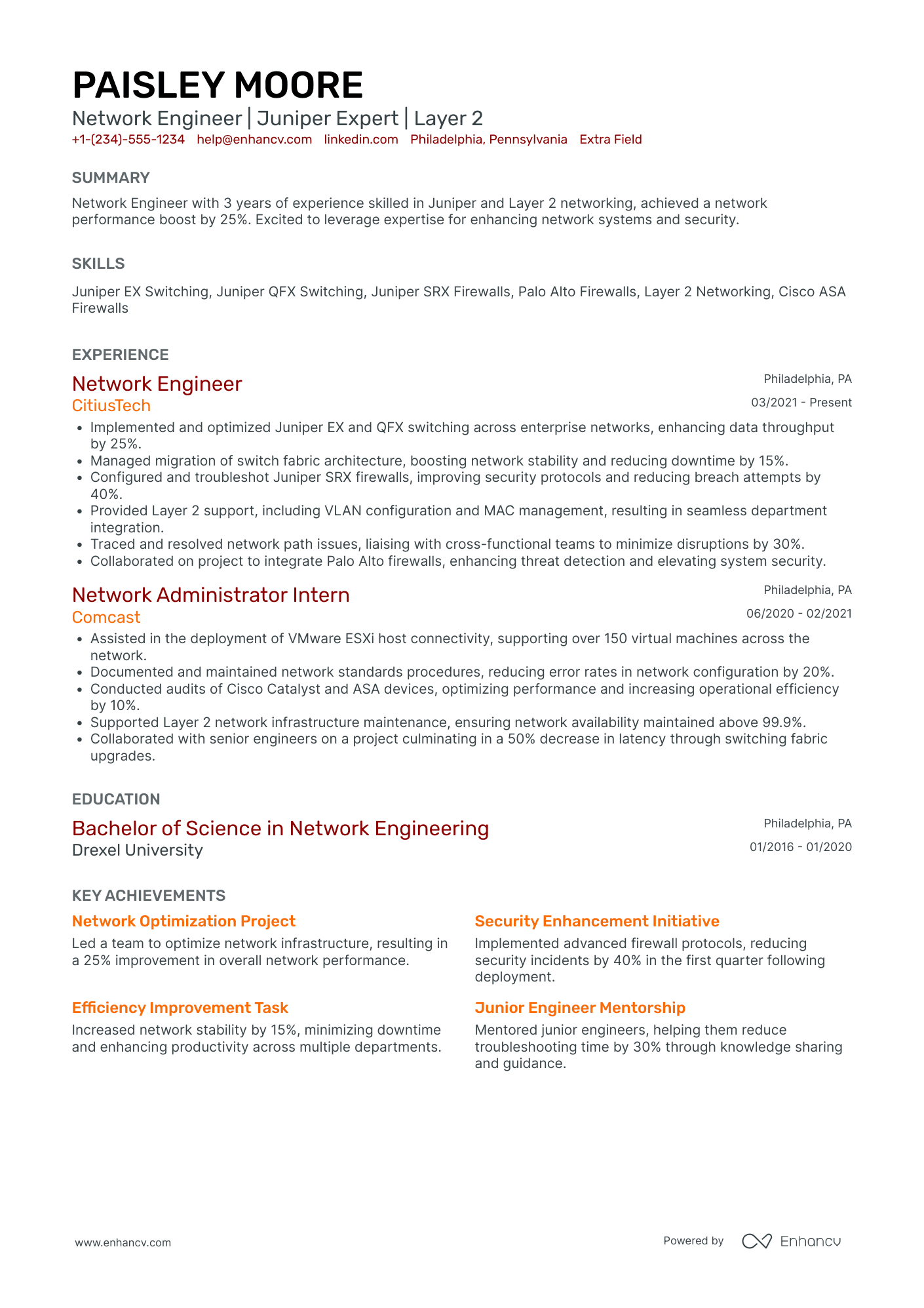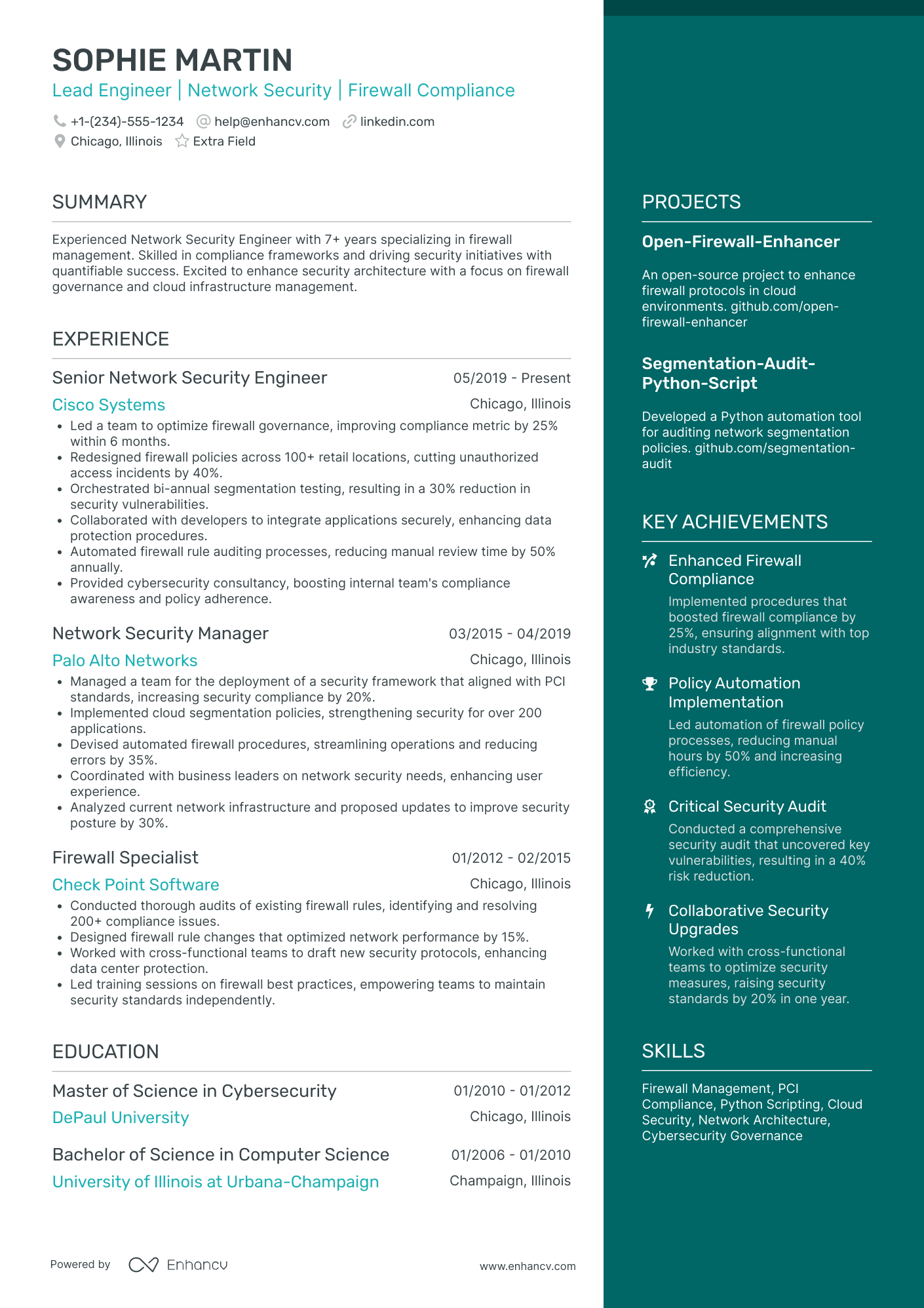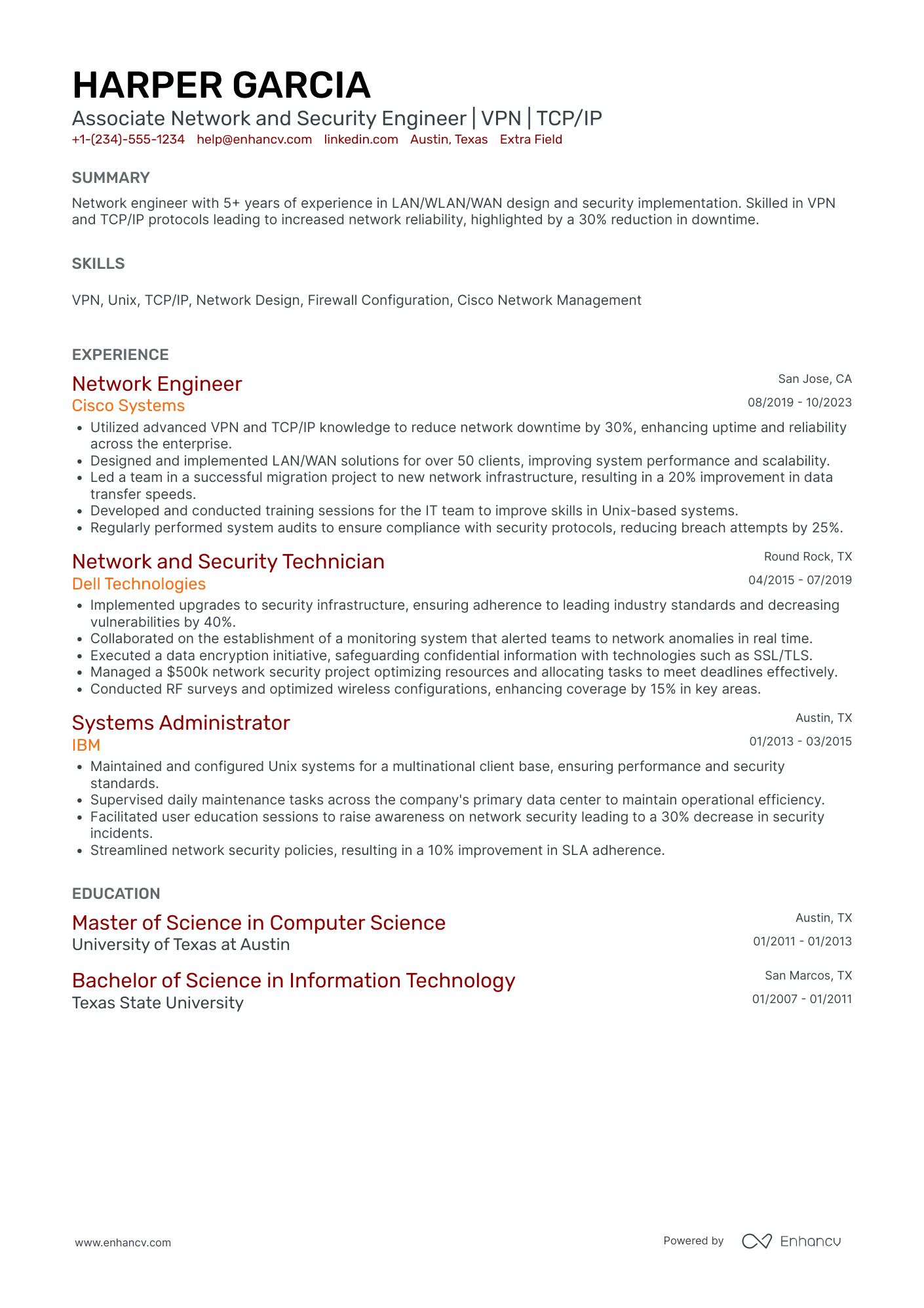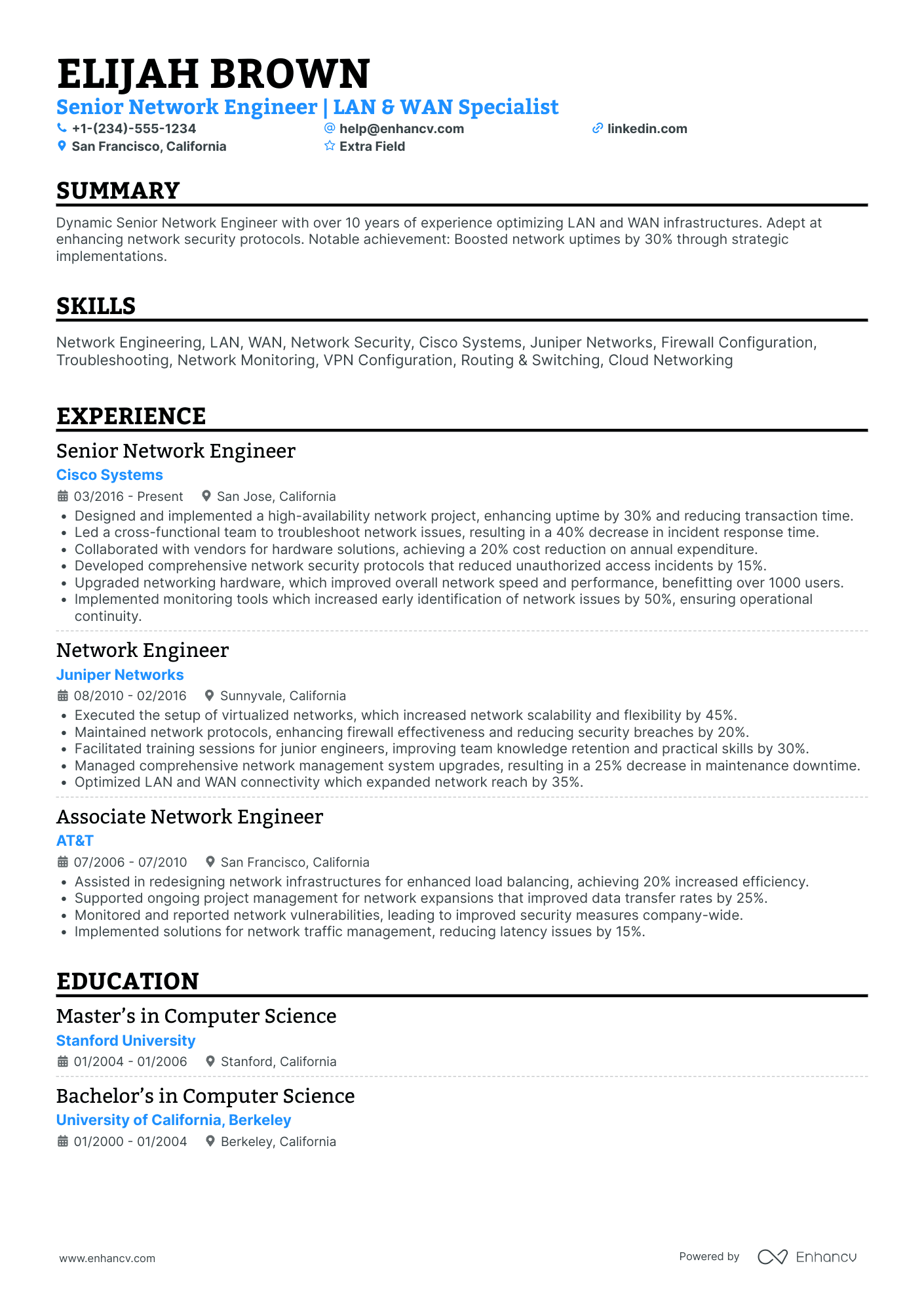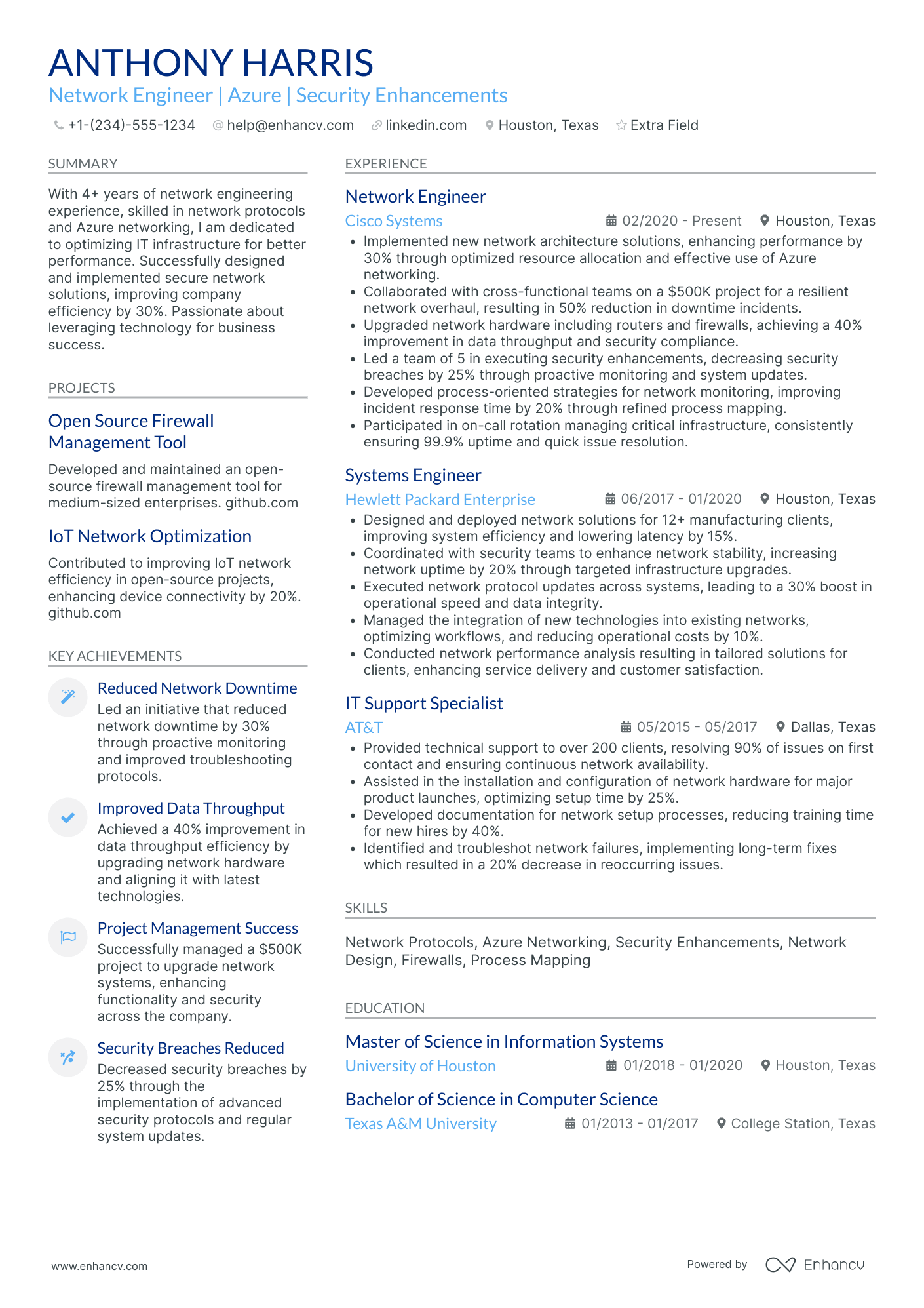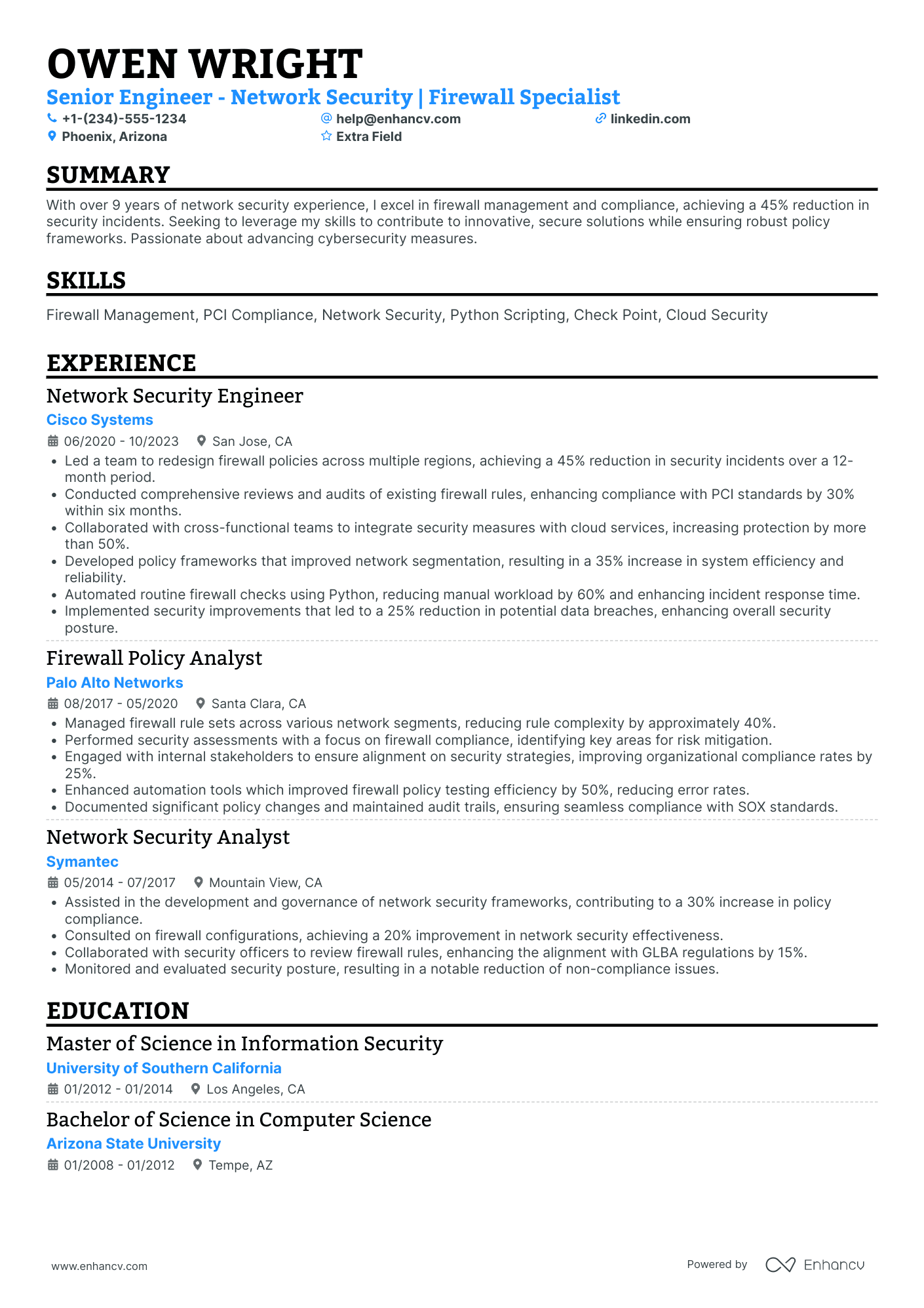Creating an attention-grabbing network security engineer resume can be a bit problematic if you aren’t aware of the common mistakes that many engineers make when updating their resumes.
You can’t just simply list your work experience and skills. You have to show actionable results of how your past security assessments and intrusion detection implementations secured the company's data.
In this guide, we’ll go over the common issues that security engineers face when describing their work and how to create a resume that:
- Details your unique technical experience with intrusion detection systems, risk assessment analysis, and other necessary tools in a way everyone can understand.
- Highlights continuing education that shows you stay current with new security threats and detection and prevention tools.
- Illustrates experience with protecting sensitive or proprietary information without breaking NDAs or exposing any past employers' metadata or security protocols.
- Targets your resume using relevant skills and experience that match the keywords and technologies from the job post.
We’ll use real-world network security engineer resume examples from working professionals to guide you toward creating a well-formatted resume that accurately details your career accomplishments and technical prowess. We’ll go over how to format each section and introduce you to some of Enhancv customizable sections that will help you make a great impression.
If this guide does not suit your exact career plans, check out these resume guides for relatable roles:
To build a well-secured network, you need to start with a solid foundation upon which to build. Your resume is the same.
We’ll first go over how to properly format your resume before adding your professional summary, work experience, education, and hard and soft skills.
How to Format a Network Security Engineer Resume
Your resume, regardless of the job or industry, must follow a specific format to be accepted. While this may sound limiting, there are many different styles and designs that you can use when formatting your resume.
The standard resume format is similar to that of any new word-processing app, like Word or Google Doc. These settings include:
- One-inch margins and single-line spacing so that your resume is easy to read and evenly spaced throughout the page.
- A black serif or sans serif font between 10-12 points. This is the optimal font size for printing and allows you to maximize the page space.
- Individual resume sections so you can keep your education, experience, and other required information separate and in neatly formatted sections.
- Options for a single or two-column format. Single-column formats are best for entry-level network security engineers, while a two-column format is best for more experienced engineers with more skills and accomplishments to list.
Your resume should be no more than two pages. That is enough space to list your career statement, work experience, education, and various technical and interpersonal skills.
When you are ready to submit your resume to a job, send it as a PDF document type (.pdf). This is the preferred document type when submitting your resume, as it preserves the format and is accessible on all operating systems and devices.
Enhancv resume templates come preset with all of the required sections and a long list of modern fonts, like Exo 2, Lato, Montserrat, Railway, Rubix, and Volkhov. You can choose from several different styles that include unique features, like single and two-column layouts, colored backgrounds, graphics, icons, embedded QR codes and videos, and other customizable features.
For more technical positions like network security engineers, the best layout to use a a modern, two-column resume format. This format allows you to add concise, essential information in easy-to-read sections that use unique colors, icons, and graphics to help you stand out.
All of our templates are accepted by applicant tracking systems (ATS), despite any rumors or myths you may have heard. The popularity of these programs with placement agencies and large organizations makes using the correct format even more important today than ever.
Different markets have specific resume formats – a Canadian resume could vary in layout.
If you have a network security engineer resume ready to go and want a free analysis, run it through our resume checker for an in-depth review and tips on how to improve it.
Is your resume good enough?
Drop your resume here or choose a file. PDF & DOCX only. Max 2MB file size.
Let’s review the required resume sections that we will be talking about during this guide.
The top sections on a network security engineer resume:
- Professional summary: A brief description of your experience, knowledge, and skills in a way that quantifies accomplishments in risk assessments, cloud security, and other technical skills.
- Skills and proficiencies: A list of hard and soft skills that demonstrate experience in cloud security management, digital forensic tools, problem-solving skills, leadership skills, and other essential skills.
- Work experience: The resume experience section is where you will detail part and full-time jobs, contract or temporary gigs, and professional freelance work that quantifies your accomplishments.
- Certifications and Training: Demonstrating a foundation of knowledge through post-secondary education, technical certifications, and continuing education courses is a necessity.
- Projects or achievements: This section allows you to showcase various security projects, like the design and implementation of security systems, employee networks security training programs, and other noteworthy accomplishments.
One way to avoid having your resume passed over is by making sure you include the kind of information hiring managers are looking for.
What recruiters want to see on your resume:
- Proficiency in security protocols: Recruiters want to see experience in SSL/TLS, IPsec, cloud security, and other security protocols in a way that demonstrates your ability to secure all types of data.
- Experience with firewalls and network security tools: You need to highlight practical and advanced knowledge of Cisco, Watchguard, or Fortinet firewalls to demonstrate your network hardening skills.
- Certification in network security: Network security is an ever-changing field, and HR managers need to know you have up-to-date training in the latest security technologies, like CrowdStrike Falcon and Darktrace.
- Problem-solving skills: Recruiters want to see examples of your problem-solving abilities and out-of-the-box solutions for preventing security breaches and reducing any downtime caused by an attack.
- Knowledge of encryption algorithms: Showing experience with OpenSSL or Microsoft Bitlocker will demonstrate your ability to transform data into ciphertext.
Now that you have your resume properly formatted, we are ready to start adding your relevant information.
How to Write Your Network Security Engineer Resume Experience
The resume experience section is where you will add your network security experience in a way that does more than just list the job duties and responsibilities. How can you do this? By adding relevant keywords that you find in the job post and company description.
Say you are applying for a job that lists this as one of the job requirements, “Create security related artifacts by working with administrators/integrators to create/validate BOE and load into eMASS.”
You want to make sure your resume experience includes the phrases “created security-related artifacts” and “create or validate BOE and load into eMASS” in one of the bullet points.
When adding your past work experience, you want to include:
- Your official job title.
- The name and location of the company and a brief description of the industry type.
- Dates of employment.
- 3-5 concise bullet points about the type of work you did and the results of that work.
You only need to include three jobs that best represent your skills and demonstrate the required duties of the job position. Any more, and you run the risk of going over that two-page limit.
In which order should you list your work experience? The standard way to list your work experience is in reverse chronological order, which puts your most recent work experience first. Those engineers with more short-term contract jobs can list their work experience in chronological order, which places jobs with the most relevant skills at the top of the list.
Let’s look at a real-world network security engineer resume experience example to demonstrate how to format this section.
- •Installed Cisco TX 9000 to increase performance at the corporate office.
- •Acting as SME to other engineers.
- •Maintained multi-vendor core and edge backbone system.
- •Upgraded Cisco routers at locations throughout California.
- •Invoiced clients for managed services.
This first example shows what most security engineers will do when they list their past work experience. They list the duties and responsibilities of the job but fail to show how they used their skills and expertise to protect the company’s data.
For instance, when listing “upgraded Cisco routers,” recruiters want to see specifics. How many routers did you upgrade? What did you upgrade to? What benefit came from the upgrade? Inquiring minds want to know.
Let’s see what adding some specific details can do to this example.
- •Installed Cisco TX 9000 to improve company’s video conferencing capabilities while ensuring all incoming and outgoing feeds are stable and secure.
- •Acted as SME to other engineers, making scripts to minimize errors and speed up delivery by 70%.
- •Maintained a 1400+ multi-vendor core and edge backbone for enterprise and consumer traffic and implemented new monitoring tools which led to a 27% decrease in security vulnerabilities.
- •Upgraded 20+ Cisco ISR G2 VGW/CUBE/SRST routers, which improved application performance and WAN offloads by 30%.
- •Invoiced $225,000 worth of managed services for clients, ranging from managing firewall performance, securing VPN services, compliance management, email security, and other services.
If you were responsible for hiring a network security engineer, which example would impress you more? The revised example does a better job of describing their experience in a way that clearly defines their abilities and accomplishments.
This example does a better job of:
- Using numbers and percentages to quantify your work experience.
- Listing experience with specific network security hardware and software.
- Highlighting increases in profits generated by their work.
- Detailing teaching and leadership skills.
Not quantifying past work experience is a common problem for security engineers. In the next section, we’ll show you several network security metrics that you can quantify.
How to quantify impact on your resume
Quantifying your past work experience gives hiring managers and placement agencies a better idea of your skills and accomplishments. It’s like adding another layer of protection to your network that fully details every step it takes to secure your data.
Take a look at these real-world examples of the top network security metrics that recruiters want to see quantified:
- Number of security audits: “Performed twice-weekly threat analysis in a 24/7 environment, mitigating and managing all threats and risks to the company and gaining 99% security data.”
- Reduction in security incidents: “Conducted a comprehensive security risk assessment, identifying and prioritizing critical risks and recommended security enhancements that resulted in a 40% reduction in overall risks.”
- Number of security devices implemented or maintained: “Designed, built, configured, and deployed 50+ firewall, intrusion detection, and infrastructure automation technologies.”
- Number of data breaches mitigated: “Leveraged the Metasploit Framework to perform weekly penetration testing, which reduced potential security breaches by 27%.”
- Number of employees trained: “Trained and managed a team of 13 security practitioners responsible for delivering security engineering and architectural expertise for customers in the Pacific Northwest.”
- Size of network infrastructure managed or protected: “Designed and implemented a new network infrastructure for a 350-bed hospital with 1,400 employees, resulting in a 25% increase in network speed and a 15% reduction in downtimes.”
- Number of software or system vulnerabilities discovered and remediated: “Identified and investigated 100% of threats and vulnerabilities, reducing the risk of successful cyber attacks by 83%.”
- Percentage improvements in system uptime or network performance: “Collaborated with cross-functional teams to implement security controls and solutions, resulting in a 25% reduction in security incidents and a 20% increase in network performance.”
Which network security metrics should you quantify? You want to include those metrics found in the job post. If the job details state, “Entré Computer Solutions is seeking an experienced professional who has earned their CCNA and is proficient with various Switch Manufacturers and Security Protocols. Ideal candidate will have at least 3 years of experience. Certifications a definite plus.”
Along with drawing attention to your CCNA certification, you would focus on quantifying your experience with Switch Manufacturers and Security Protocols.
You can use Enhancv technical section to list which hardware and software you have experience in.
The next section is for those who have no industry experience and are looking for their first network security job.
How do I write a network security engineer resume with no experience
Applying for an entry-level network security position can be a bit stressful if you don’t know what kind of jobs you should highlight on your resume. Do you include those summer retail sales or bartending jobs or other non-network security jobs?
You only need to include those jobs where you:
- Configured firewalls, routers, and other networking devices
- Learned the fundamentals of security principles
- Used simulation software, like GNS3 or Cisco Packet Tracer, to simulate network environments.
- Worked as part of a team to secure and maintain a network.
- Assisted in implementing and maintaining large-scale networks.
- Worked in a tech call center to aid callers in computer and networking issues.
If you are creating a network security engineer resume with no experience, you can take advantage of additional resume sections to list your relevant skills. Enhancv has a number of resume sections that inexperienced engineers can utilize to beef up their resumes:
- Volunteer section: Helping a non-profit organization or community center improve computer and network infrastructure and protect customer data shows your dedication to helping others while demonstrating your network security skills and knowledge.
- Reference section: Including references from past employers, college professors, or other professionals can give recruiters a better sense of your abilities and dedication to network security.
- Projects section: You can include any personal or freelance projects where you fortified networks, performed threat assessments, or implemented advanced security protocols.
Now that we have added your past work experience, we’ll go over how to add technical and interpersonal skills that make you a well-rounded network security engineer.
How to List Your Hard Skills and Soft Skills on Your Resume
When detailing your past work experience, you’re only going to include those hard and soft skills that are required for the job. If the job post calls for experience configuring Cicso switches, you would not include your experience in programming a Dell or Netgear switch in the job details.
You can list relevant but non-essential hard skills in smaller technical resume sections.
What are hard and soft skills? Hard skills cover technical and business skills that you pick up through college courses, internships, and on-the-job training. They include necessary skills such as cryptography, risk assessments, firewall hardening, securing wireless networks, and ethical hacking.
Soft skills are those skills that make you an effective leader and help you come up with creative solutions to complex problems and stay cool and collected during stressfull moments. You learn these skills from daily interactions with your friends, family, peers, and mentors.
Showcasing a wide range of technical skills is imperative for all network security engineers as recruiters like to see experience with multiple hardware and software. Enhancv technical skills section allows you to detail your technical proficiencies separated by different groups, like so.
To give you a more targeted resume, you can tailor this section to include those skills listed in the job description.
Check out this list of the top hard and soft skills that HR teams and recruiters like to see from their prospective candidates.
Best hard skills for your network security engineer resume
- Firewall administration
- Intrusion detection systems
- Endpoint security
- Network protocols
- Virtual Private Networks (VPNs)
- Cryptography
- Risk assessment
- Penetration testing
- Security information and event management (SIEM)
- Cloud security
- Antivirus and antimalware software
- Data loss prevention (DLP)
- Identity and access management (IAM)
- Security architecture design
- Cybersecurity software tools
- Network monitoring software
- Ethical hacking
- Programming languages like Python and Java
- Linux OS
- Advanced security training
To display your various soft skills, use Enhancv passions, strengths, or hobbies and interests sections. Each section is fully customizable with icons, graphics, and customizable titles.
Best soft skills for your network security engineer resume
- Problem-solving abilities
- Attention to detail
- Strong communications
- Teamwork
- Leadership
- Time management
- Crisis management
- Strategic thinking
- Decision making
- Adaptability
- Ethical judgment
- Resilience
- Proactive learning
- Customer service
- Trustworthiness
- Project management
- Analytical mindset
- Ability to work under pressure
- Patience
Another must-have section for all resumes is the education section. Here, you will include any bachelor’s or master’s degrees in computer information, network security, or other accredited technical degrees.
How to List Your Certifications and Education on Your Resume
All candidates are required to include their post-secondary education and any advanced training. Without an education section, you may not be considered qualified for the position.
Network security is a highly skilled and technical position where minor mistakes can lead to losing your customer’s data, proprietary information, or digital currency. You must demonstrate a solid foundation of knowledge that’s essential for all network security engineers.
Each education entry will need the following:
- Degree type and major
- School name
- Location
- Dates of enrollment/graduation date
- A list of computer and network security-related courses, recognitions, and accomplishments
If you have four or more years of network security engineer experience, you don’t need to include details about your coursework and school-time activities. This is for those with little to no work experience or for specialized continuing education courses.
- •540 hour course covering the fundamental aspects of networking and cyber security.
- •Penetration testing
- •Cisco networking
- •Privilege escalation
- •Attacks & attack vendors
- •Scripting/assembly languages
- •Malware analysis
- •Reverse engineering
All education and specialized courses should be listed in reverse chronological order.
If you are looking to increase your skills and earning potential, consider applying for one of these certifications.
Best certifications for your network security engineer resume
You can list this advanced training in our certification section. Include the certification name and the organization that provided the training, like so.
The next section is where you can add a professional statement to list some of your accomplishments and impress your potential employer.
How to Write Your Network Security Engineer Resume Summary Or Objective
The last required resume section that we’ll talk about is one of the first things recruiters and HR staff will read. This is the first chance to impress and you’ll want to tailor it to the job duties and responsibilities.
A resume summary is for more experienced network security engineers who have 5 or more years of experience. It is a concise, 3-5 sentence summary of their experience and accomplishments and quantifies key metrics.
You will write a resume objective if you are fresh out of college and looking for your first networking or data security job or for those who are switching careers. This format lists your career objectives in 2-4 sentences and briefly mentions your plan to achieve your goals.
Let’s look at an example of a network security engineer resume summary.
From reading this example, you would not get much of a sense of how long this person has worked as a network security engineer, what industry they specialize in, or how their actions impacted the company and its customers. All of which this section is capable of doing.
Be specific with your summary, and add relevant details in a way that everyone can understand.
Now, we have a resume summary that makes a great first impression and is specific in their accomplishments and areas of expertise. This example clearly states:
- Number of years of experience.
- Type of industry they have experience in.
- Names of networking and security hardware and tools they have experience with.
- Quantifies relevant metrics that are specific to the job post.
By adding a few details, you can turn your professional statement into an attention-grabbing introduction that prompts them to continue reading.
Optimize your resume summary and objective for ATS
Drop your resume here or choose a file.
PDF & DOCX only. Max 2MB file size.
Additional Sections for a Network Security Engineer Resume
We’ve added many details about your experience and skills, and many engineers will stop there, thinking their resume is good to go. We’re close, but not quite.
Network security is one of the fastest-growing technology fields, and recruiters get hundreds of resumes for a single position. How can you further stand out in a crowded field? By including some additional resume sections that demonstrate more of your network security skills.
Consider adding the following resume sections:
- Awards and recognitions: This section is a great way to show off any local or national awards, like the (ISC)² Global Achievement Awards or the Cybersecurity Excellence Awards.
- Published articles: Listing any published technical How-To articles, research papers, or case studies is a great way to highlight your expertise in a specific field.
- Presentations/Teaching seminars: Another way to demonstrate your experience and knowledge is by including any speaking engagements, seminars, or classes you’ve led regarding network security.
- Professional affiliations: This section allows recruiters to see that you are active within the network security industry and your dedication to staying current to new technologies and security threats and actively building professional relationships.
These sections make a great addition to your resume and fit perfectly in our two-column resume format.
Adding a project portfolio to your network security engineer resume
Experienced network security engineers will work on many different types of projects that they can use to demonstrate their skills to potential employers.
You can demonstrate how you performed network security audits, penetration testing exercises, the development of security policies and procedures, security training and awareness campaigns, and other relevant information in a project portfolio.
The top websites where you can create a portfolio include:
Use the resume header to add a link to your portfolio instead of a social media account.
Key Takeaways
Congratulations! You now have a professional network security engineer resume that will increase your chances of getting an interview. We’ve covered a lot of important information, and you now know how to create a resume that:
- Demonstrates essential hard and soft skills through multiple resume sections.
- Uses numbers and percentages to quantify various network security metrics that are tailored to the job.
- Uses an appropriate mix of technical jargon without being too overly technical or confusing to placement agencies and HR staff who are not very technical.
- Shows your passion for learning new security procedures and hardening techniques through continuing education courses and technical certifications.
Network Security Engineer resume examples
By Experience
